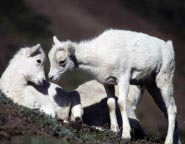 Dall's sheep (Ovis dalli) is a wild sheep that is native to western Canada and the United States. These sheep, who can range in color from white to almost black and have curved horns, can be found high on the mountains in northwestern Canada and Alaska. Female ewes weigh a maximum of around 68 kilograms (150lbs) and the male rams can weight up to 113 kilograms (249lbs). Both ewes and rams stand up to be 90 centimeters (35 inches) at their shoulders. Body length also varies from 1.3 to 1.8 meters (51 inches to 70 inches) in males and 1.3 to 1.6 meters (51 inches to 63 inches) in females.
Dall's sheep (Ovis dalli) is a wild sheep that is native to western Canada and the United States. These sheep, who can range in color from white to almost black and have curved horns, can be found high on the mountains in northwestern Canada and Alaska. Female ewes weigh a maximum of around 68 kilograms (150lbs) and the male rams can weight up to 113 kilograms (249lbs). Both ewes and rams stand up to be 90 centimeters (35 inches) at their shoulders. Body length also varies from 1.3 to 1.8 meters (51 inches to 70 inches) in males and 1.3 to 1.6 meters (51 inches to 63 inches) in females.Both male and female Dall's sheep have curved horns, but the male's horns are much larger and thicker, and generally take about eight years until they are fully formed. Their horns are made of keratin, the same substance that your fingernails are made from.
Dall's sheep enjoy a diet of grasses, sedges, moss, lichens and willow. They will travel across vast terrain for the minerals provided by a salt lick. In the summer when food is abundant, a wide variety of plants and other vegetation are consumed. In the winter, they subsist of mostly dry, frozen grasses. These sheep have the ability to live in the harshest of environments, below the Arctic and in the Arctic Regions.
These sheep love mountainous slopes because it's easy for them to get away from their predators on the rocks. Their predators are bears, wolves and golden eagles. Not to mention, people! These sheep are considered to be of the least concern with regards to conservation, meaning they are not endangered in any way.
A fun way to tell the age of a sheep is to look at its horns. The bigger they are, the older the sheep is, and they don't grow in the winter. Since they stop growing in the winter, the horns get growth rings. If you count these growth rings, you can tell the age of the sheep. The horns of the Dall sheep will be half a circle in about three years (seen from top), .75 of a circle in five and a full circle in about eight years. Simply count the growth rings on the horns and you'll know the age of the sheep.
Keywords: white , brown , horn , gray , black
The Dall's sheep, thinhorn sheep is listed as Least Concern (LR/lc), lowest risk. Does not qualify for a more at risk category. Widespread and abundant taxa are included in this category, on the IUCN Red List of Threatened Species
Namings for the Dall
A young / baby of a Dall is called a 'lamb'. The females are called 'ewe' and males 'ram'. A Dall group is called a 'drove, flock or herd'.Some facts about the
Dall's sheep
Adult weight : 73.1 kg (160.82 lbs)
Maximum longevity : 20 years
Female maturity :684 days
Male maturity : 639 days
Gestation : 173 days
Weaning : 129 days
Litter size : 1
Litters per year : 1
Interval between litters : 365 days
Weight at birth : 2.819 kg (6.2018 lbs)
Mortality rate doubling time : 2 years

Custom Search